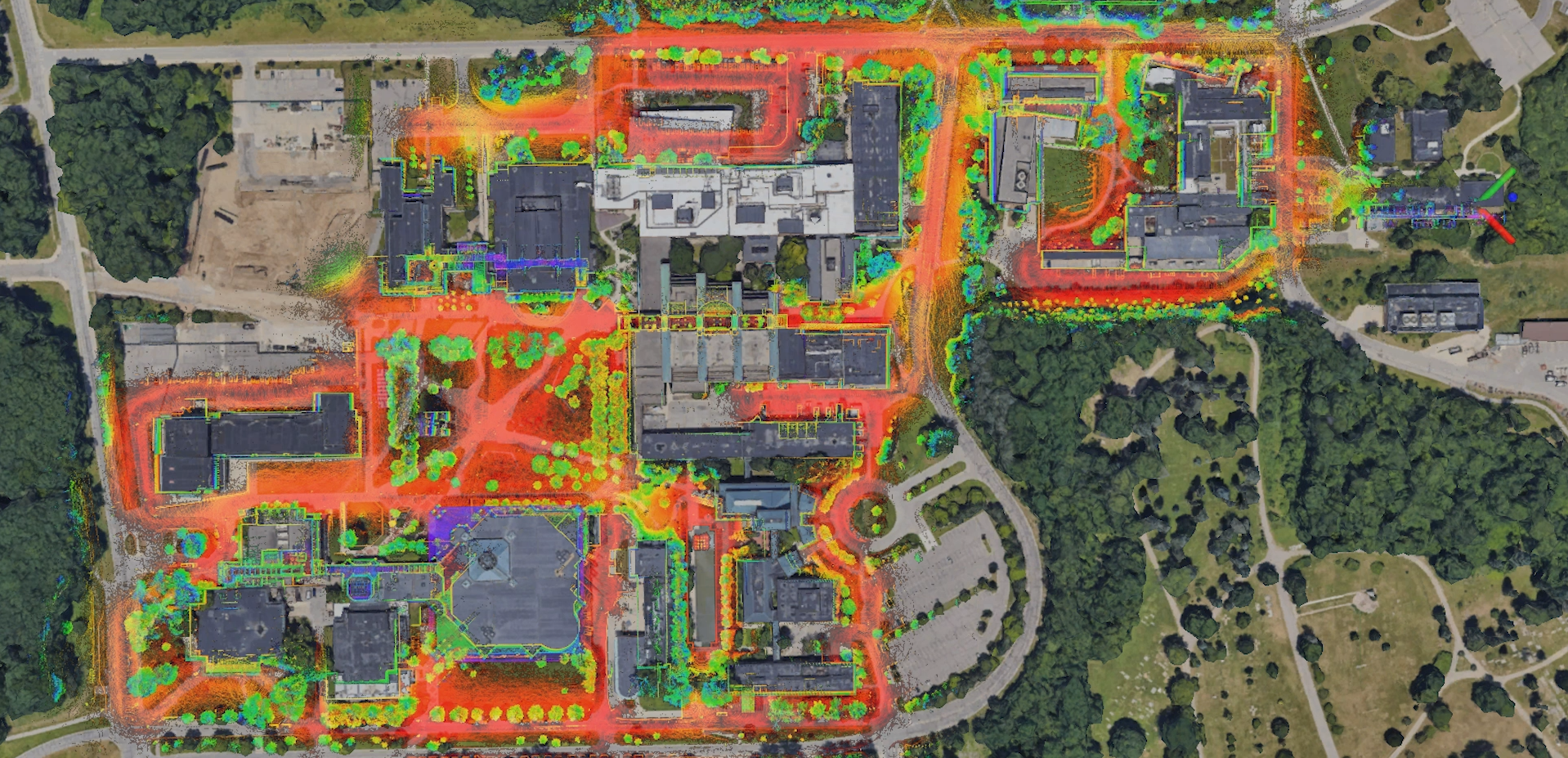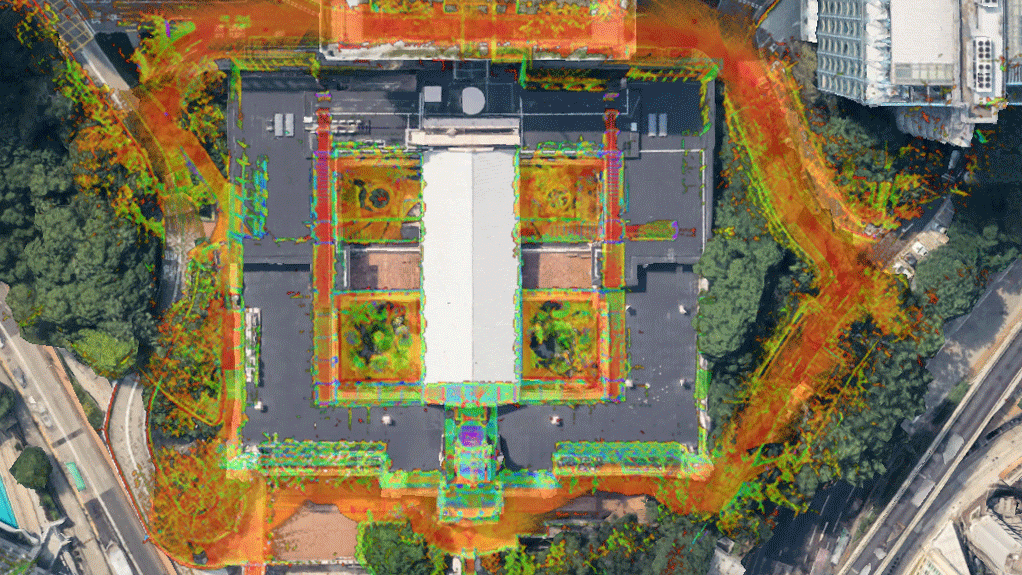This work proposes an incremental Generalized Iterative Closest Point (GICP) based tightly-coupled LiDAR-inertial odometry (LIO), iG-LIO, which addresses the challenges of integrating GICP into real-time LIO. The main contributions are as follows.
- The raw GICP constraints are tightly-coupled with IMU constraints in a Maximum A Posteriori (MAP) estimation.
- A voxel-based surface covariance estimator (VSCE) is proposed to improve the efficiency and accuracy of the surface covariance estimation. Compared to the kd-tree based methods, VSCE reduces processing time in dense scans while maintaining the accuracy of iG-LIO in sparse and small FOV scans.
- An incremental voxel map is designed to represent the probabilistic models of surrounding environments. Compared to non-incremental methods (e.g., DLIO), it successfully reduces the time cost required for the nearest neighbor search and map management.
- Extensive datasets collected from different FOV LiDARs are adopted to evaluate the efficiency and accuracy of the proposed iG-LIO. Even though iG-LIO keeps identical parameters across all datasets, the results show that it is more efficient than Faster-LIO and achieves competitive performance compared to state-of-the-art LIO systems.
The experiment video can be found on YouTube , bilibili.
The docker-based standard development environment is available at https://github.com/zijiechenrobotics/ig_lio_workspace
1️⃣ Ubuntu and ROS
Ubuntu >= 18.04. And Ubuntu 20.04 is recommended.
2️⃣ GCC & G++ (only for Ubuntu 18.04)
gcc & g++ >= 9
3️⃣ TBB (only for Ubuntu 18.04)
TBB >= 2020. Please follow https://github.com/oneapi-src/oneTBB
4️⃣ livox_ros_driver
git clone https://github.com/Livox-SDK/Livox-SDK
cd Livox-SDK
mkdir build
cd build
cmake ..
make -j
sudo make install5️⃣ glog
sudo apt-get install -y libgoogle-glog-devcd <your workspace>
mkdir src
cd src
git clone https://github.com/zijiechenrobotics/ig_lio_workspace.git
git clone https://github.com/Livox-SDK/livox_ros_driver
cd ..
catkin_makeDownload NCLT from http://robots.engin.umich.edu/nclt/
source devel/setup.bash
roslaunch ig_lio lio_nclt.launchDownload NCD from https://ori-drs.github.io/newer-college-dataset/
source devel/setup.bash
roslaunch ig_lio lio_ncd.launchDownload ULHK from https://github.com/weisongwen/UrbanLoco
source devel/setup.bash
roslaunch ig_lio lio_ulhk.launchDownload AVIA from https://drive.google.com/drive/folders/1CGYEJ9-wWjr8INyan6q1BZz_5VtGB-fP (fast-lio) and https://github.com/ziv-lin/r3live_dataset (r3live)
source devel/setup.bash
roslaunch ig_lio lio_avia.launchThe fast-lio datasets miss the gravitational constant in the accelerometer. Please edit the avia.ymal
# for fast-lio
enable_acc_correct: true
# for r3live
enable_acc_correct: falseDownload Botanic Garden from https://github.com/robot-pesg/BotanicGarden
source devel/setup.bash
# for avia
roslaunch ig_lio lio_bg_avia.launch
# for velodyne
roslaunch ig_lio lio_bg_velodyne.launch1️⃣ Edit .yaml files in ig_lio/config
lidar_topic: LiDAR topic name.imu_topic: IMU topic name.lidar_type: The type of LiDAR you use. Only support for Velodyne, Ouster, and Livox.min_radius&max_radius: A range filter to remove laser point from the robot itself.enable_ahrs_initalization: Set true or false. If the IMU message has orientation channel, iG-LIO can be initialized via AHRS.enable_acc_correct: Set true or false. If the accelerometer miss the gravitational constant, please set true (e.g., fast-lio2 datasets).gravity: Make sure the gravity is correct. Some datasets are 9.81, some datasets are -9.81, and even zero (e.g., ULHK). A simple debugging method is to observe the glog message. The normal range of ba_norm is 0~0.5.t_imu_lidar&R_imu_lidar: The extrinsic parameters from LiDAR frame to IMU frame (i.e. the IMU is the base frame).
2️⃣ Launch iG-LIO
source devel/setup.bash
roslaunch ig_lio <your launch file name>.launch
rosbay play <your rosbag>We use abbreviations for all sequences due to limited space. The full names of all sequences are presented below.
| Abbreviation | Name | Distance(km) | Sensor Type |
|---|---|---|---|
| nclt_1 | 2012-01-15 | 7.58 | Velodyne HDL-32E |
| nclt_2 | 2012-04-29 | 3.17 | Velodyne HDL-32E |
| nclt_3 | 2012-05-11 | 6.12 | Velodyne HDL-32E |
| nclt_4 | 2012-06-15 | 4.09 | Velodyne HDL-32E |
| nclt_5 | 2013-01-10 | 1.14 | Velodyne HDL-32E |
| ncd_1 | 01_short_experiment | 1.61 | Ouster OS1-64 |
| ncd_2 | 02_long_experiment | 3.06 | Ouster OS1-64 |
| ncd_3 | 05_quad_with_dynamics | 0.48 | Ouster OS1-64 |
| ncd_4 | 06_dynamic_spinning | 0.09 | Ouster OS1-64 |
| ncd_5 | 07_parkland_mound | 0.70 | Ouster OS1-64 |
| ulhk_1 | HK-Data20190117 | 0.60 | Velodyne HDL-32E |
| ulhk_2 | HK-Data20190426-2 | 0.74 | Velodyne HDL-32E |
| bg_1 | 1006-01 | 0.76 | Velodyne VLP-16 & Livox AVIA |
| bg_2 | 1008-03 | 0.74 | Velodyne VLP-16 & Livox AVIA |
| avia_1 | hku_main_buiding | 0.96 | Livox AVIA |
| avia_2 | outdoor_Mainbuilding_100Hz_2020-12-24-16-46-29 | 0.14 | Livox AVIA |
| avia_3 | outdoor_run_100Hz_2020-12-27-17-12-19 | 0.09 | Livox AVIA |
We aligned the mapping results of iG-LIO with Google Earth and found that iG-LIO retains global consistency maps.
Thanks for citing iG-LIO (RA-L 2024) if you use any of this code.
# IEEE Robotics and Automation Letters ( Early Access )
@ARTICLE{10380742,
author={Chen, Zijie and Xu, Yong and Yuan, Shenghai and Xie, Lihua},
journal={IEEE Robotics and Automation Letters},
title={iG-LIO: An Incremental GICP-based Tightly-coupled LiDAR-inertial Odometry},
year={2024},
volume={},
number={},
pages={1-8},
doi={10.1109/LRA.2024.3349915}}
Thanks for the below great open-source project for providing references to this work.
- LOAM (J. Zhang and S. Singh. LOAM: Lidar Odometry and Mapping in Real-time)
- FAST-LIO
- Faster-LIO
- LINS
- SLICT
Thanks for the following public dataset.
| Time | Event |
|---|---|
| Aug 13, 2023 | 😀 Paper submitted to IEEE Robotics and Automation Letters (RA-L) |
| Nov 5, 2023 | 😭 Revise and resubmit |
| Dec 22, 2023 | 🥳 Paper accepted for publication in RA-L |
| Current | 🎉 Source code released |



